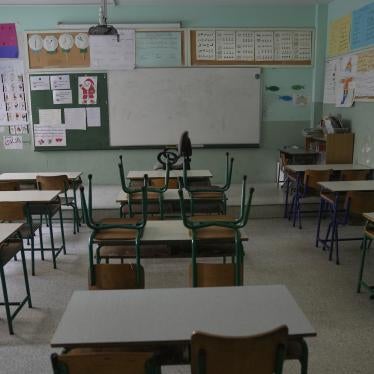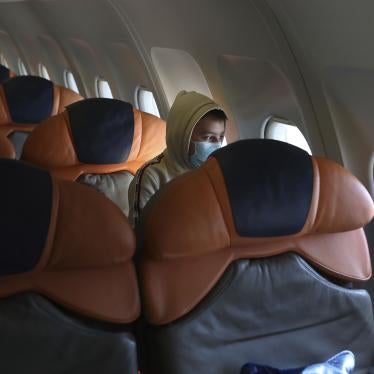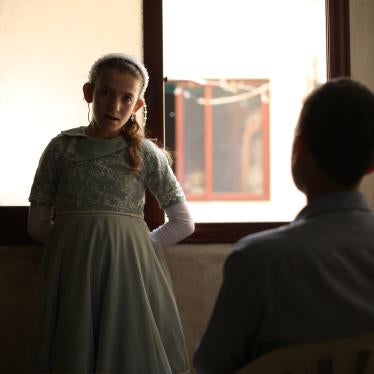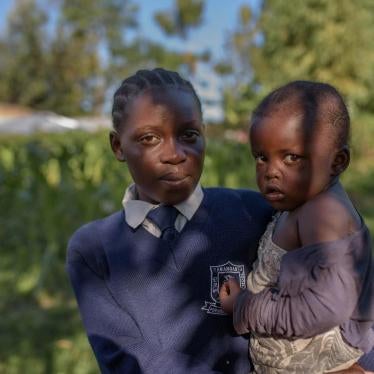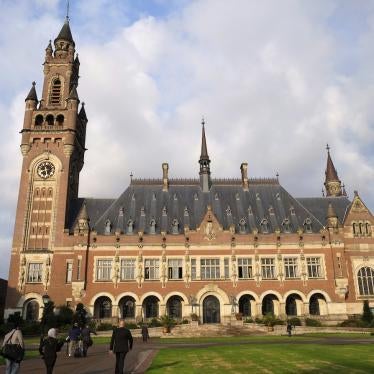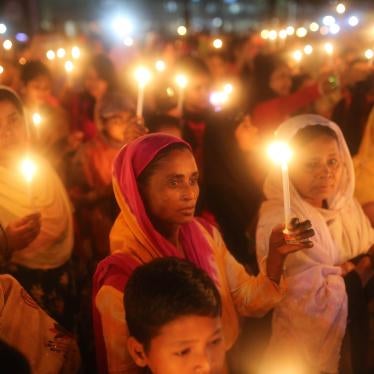80th Pre-sessional Working Group
June 2018
We write in advance of the Committee on the Rights of the Child pre-sessional review of Syria to highlight grave concerns including summary executions of children, unlawful attacks that killed or maimed children, the torture and ill-treatment of children in detention, the military use of schools, and attacks on education and hospitals. The examples in this submission are not exhaustive but intended to illustrate areas of concern.
Human Rights Watch has documented violations of children’s rights by all parties to the conflict in Syria, but this submission focuses on Syrian government abuses.[1]
Video Evidence
Syria: New Evidence Shows Pattern of Chemical Weapons Use (May 1, 2017), https://www.youtube.com/watch?v=cVGDcReFz9k&t=0s&list=PL8EC5D4B1345E3E9D&index=16
Aleppo: Russia and Syria Kill 400 Civilians, 90 Children in a Month (December 1, 2016), https://www.youtube.com/watch?v=57dn824aLec&list=PL8EC5D4B1345E3E9D&index=26
Syria: Mass Deaths and Torture in Detention (December 16, 2015), https://www.youtube.com/watch?v=eQni3qn6GIU&list=PL8EC5D4B1345E3E9D&index=52
Syria: Widespread Use of Incendiary Weapons (November 10, 2013), https://www.youtube.com/watch?v=soxtqJgNC7Y&list=PL8EC5D4B1345E3E9D&index=91
Syria: Chemical Attacks on Ghouta (August 21, 2013), https://www.youtube.com/watch?v=ilanR5_YeEo&list=PL8EC5D4B1345E3E9D&index=80
Syria: Attacks on Schools Endanger Students (June 5, 2013), https://www.youtube.com/watch?time_continue=8&v=7l5KIZkmB3g
Right to life, survival, and development (Articles 6, 38)
Summary executions
Syrian government forces have summarily executed children. Human Rights Watch documented the killings of at least 47 people, mainly women and children, by Syrian government forces in the `Adwiyya, Karm al-Zaytoun and Refa`i neighborhoods of Homs on March 11-12, 2012; also in mid-March, government forces entered Ayn Larouz village, in the Idlib governorate, placed local children on military vehicles as human shields, and killed four residents, including three children, whom they had detained.[2] On May 2, 2013, Syrian government forces and allied militias summarily executed 167 civilians, including 14 children, in the town of al-Bayda near the coastal city of Baniyas, after clashes with anti-government forces earlier in the day.[3]
Unlawful attacks that killed or maimed children
Human Rights Watch has documented unlawful attacks by Syrian government and anti-government forces that killed thousands of children. From July 2012 to April 2013 Human Rights Watch documented and visited the sites of 59 deliberate or indiscriminate airstrikes by government warplanes that killed 152 civilians, including children.[4] Human Rights Watch also investigated nine apparent ballistic missile attacks by Syrian government forces in 2013 that killed at least 215 people, including 100 children.[5] No military targets were struck in the attacks and in seven of the nine cases Human Rights Watch found no signs of any apparent military targets in the vicinity.
Between February 2014 and January 2015, Human Rights Watch determined at least 450 major damage sites that showed damage consistent with detonations of improvised barrel bombs dropped by Syrian government helicopters in 10 towns and villages held by rebel groups in Daraa and over 1,000 in Aleppo.[6] The Syrian Network for Human Rights estimated that aerial barrel bomb attacks had killed nearly 1,900 children in Syria during the year following the passage of UN Security Council Resolution 2139, which “demand[ed]” an end to their use, on February 22, 2014.
A Russian-Syrian aerial bombing campaign of areas in Aleppo controlled by anti-government groups from September 19 to October 18, 2016 often appeared to be recklessly indiscriminate and killed 446 civilians, including 91 children.[7] Satellite imagery that Human Rights Watch analyzed shows more than 950 new distinct impact sites consistent with the detonation of large high explosive bombs across the area during the month. The air-dropped, unguided munitions used included enhanced blast, fragmentation, and concrete-penetrating 500-kilogram bombs, cluster munitions, and incendiary weapons.
Russian and Syrian aircraft began a bombing campaign in areas of Idlib province and surrounding areas controlled by anti-government groups on September 19, 2017 that used cluster munitions, which are inherently indiscriminate, and explosive weapons with wide-area effect. Human Rights Watch investigated three air strikes conducted between September 20 and 25 that killed at least 72 people, including at least 9 children, in populated residential areas, markets and camps for the displaced.[8]
Use of chemical weapons, cluster munitions, and incendiary weapons
Syrian government forces has repeatedly used chemical weapons in attacks that killed and maimed children and other civilians.[9] On the morning of August 21, 2013, two attacks on the Damascus suburbs of Eastern and Western Ghouta controlled by anti-government groups using nerve agents and weapons that were only in the possession of Syrian government forces killed hundreds of civilians, including large numbers of children.[10] Syrian government forces have used chemical agents at least 30 more times.[11]
Human Rights Watch has found that all evidence strongly suggests that on April 4, 2017, a Syrian government warplane attacked Khan Sheikhoun, a town in the northwestern governorate of Idlib, with a nerve agent, killing at least 90 people, 30 of them children.[12] In addition, witnesses described to Human Rights Watch symptoms consistent with exposure to nerve agents after warplanes attacked eastern Hama on December 11 and 12, 2016, and northern Hama on March 30, 2017.
Government forces have used chlorine in attacks that killed children. Between April 2014 and late 2016, Human Rights Watch documented 16 Syrian government attacks with chlorine contained in improvised air-dropped munitions.[13] During the government offensive against Aleppo, Human Rights Watch documented government helicopters dropping chlorine in residential areas on at least eight occasions between November 17 and December 13, 2016, in attacks that killed at least nine civilians, including four children.[14] Government and allied ground forces also used improvised ground-launched munitions containing chlorine.[15]
The joint Syrian-Russian joint military operation repeatedly conducted attacks that killed or maimed children using cluster munitions and incendiary weapons. Government forces used at least 13 types of internationally banned cluster munitions in over 400 attacks on areas held by anti-government groups between July 2012 to August 2016, killing and injuring civilians, including children.[16] The Syrian air force has dropped incendiary weapons in populated areas in scores of instances, including on a school playground in al-Qusayr in December 2012.[17] On August 26, 2013, a ZAB-500 incendiary bomb was dropped on a school in Urm al-Kubra, Aleppo, which resulted in at least 37 civilian deaths—mostly children with an average age of 16—and 44 civilian injuries.[18]
Attacks on medical facilities and denial of medical care and humanitarian assistance (Article 38)
Syrian government forces repeatedly targeted hospitals and medical clinics, including children’s hospitals. Attacks on February 15, 2016, struck seven medical facilities and two schools in Syria, killing nearly 50 civilians, including a ballistic missile that struck the entrance of the Women and Children’s Hospital in Azaz city, which was in use at the time as a medical facility, wounding 15 staff.[19] A major airstrike by the Syrian-Russian coalition that appeared to target Aleppo’s al-Quds Hospital on April 27, 2016 killed 58 civilians.[20] In August 2016, there were attacks on health facilities including in Idlib, Aleppo, Hama, and Homs. On August 19, 2016, incendiary weapons hit a field hospital in Darya, in the suburbs of Damascus.[21] Warplanes attacked a well-known Aleppo hospital, the Sakhour Medical Center, on at least four occasions between September 28 and October 14, 2016.[22]
Syrian authorities have refused to allow children to be evacuated from besieged areas where medical care is unavailable. In November 2017, Syrian authorities’ refusals of medical evacuation requests led to the deaths of a one-year-old girl who had been born with one kidney and a boy with a heart condition, local media in Eastern Ghouta reported, and the deaths of a girl due to a cardiac disease and of another girl due to a malignant eye tumor, doctors told Human Rights Watch.[23]
Both Syrian and anti-government forces have besieged areas with civilian populations and denied or confiscated civilian goods and humanitarian aid. During the Syrian government siege of Aleppo, masked armed men looted a 31-truck UN convoy carrying humanitarian aid, and Syrian or Russian warplanes then attacked and destroyed the convoy and killed 20 civilians including humanitarian workers.[24]
The Syrian government has besieged Eastern Ghouta, an enclave controlled by anti-government groups near Damascus since 2013, but in 2017 it closed commercial crossings and further restricted the number of UN aid convoys to the area and the amount and types of goods that can be delivered. Convoys that entered since September 2017 did not contain sufficient aid, and even when permission was granted, administrative and security issues often resulted in excessive delays.[25] By November 2017, more than 12 percent of children in the enclave under 5 years old suffered acute malnutrition.[26]
We encourage the Committee to pose the following questions to the Syrian government:
- What steps has Syria taken to investigate, prosecute, and punish as appropriate members of its armed forces for summary executions of children, or for attacks that violated international law and killed or maimed children?
- What steps has Syria taken to ensure adequate food and medical care, and to facilitate humanitarian aid shipments, for children in Eastern Ghouta and in Idlib governorate in 2018?
- Have the appropriate authorities investigated allegations of unlawful attacks that harmed children or where children were wrongfully and harmfully denied medical evacuations? If so, what was the result in each case, and in terms of any substantive changes to military procedures or policies?
We encourage the Committee to make the following recommendations:
- Cease attacks targeting civilian infrastructure that do not constitute military objectives under international humanitarian law;
- Cease all use of chemical weapons, incendiary weapons, cluster munitions, and the indiscriminate use of explosive weapons with wide area effects in populated areas;
- Give up its entire stockpile of chemical weapons to the Organisation for the Prohibition of Chemical Weapons as mandated by the Convention on the Prohibition of Chemical Weapons to which it is a party;
- Cease attacks targeting medical facilities, allow medical evacuations, and facilitate unimpeded and sufficient humanitarian aid into besieged areas, and ensure that children have access to appropriate food, particularly formula milk;
- Cooperate with internationally-mandated bodies, such as by providing access and information as requested by the International, Impartial, and Independent Mechanism tasked with investigating mass atrocities in the Syrian conflict.
Attacks on education (Articles 6, 28, 38)
Attacks on schools
The Commission of Inquiry on Syria has noted that attacks on schools in Syria comprised half of all those reported worldwide from 2011 to 2015.[27] Human Rights Watch has documented that government forces carried out deliberate or indiscriminate attacks against schools. On September 29, 2013, a Syrian government airstrike using fuel-air explosive bombs hit outside a secondary school in Raqqa city, then held by anti-government groups, killing at least 14 civilians. At least 12 of those killed were students attending their first day of classes.[28] On March 26, 2014, two barrel bombs hit two schools in Dael, in Daraa governorate, and a third hit a school bus there, killing or wounding a dozen children.[29] On February 15, 2016, a ballistic missile apparently launched by Syrian government forces hit a school where displaced people had been staying in the village of Kaljabrin, about eight kilometers southeast of Azaz, killing 15 people, including children.[30]
Airstrikes by the joint Russian-Syrian military operation hit a school complex in the village of Haas in Idlib on October 26, 2016, and killed dozens of people, mostly schoolchildren and teachers.[31] Satellite imagery of Haas after the attack showed damage signatures consistent with airstrikes, including two impacts on schools in the complex. The Russian Defense Ministry denied that the attacks took place, but it presented drone footage that shows, and even marks, damage that matches the damage visible in the satellite imagery, and that is consistent with videos of the attack and witness statements. In 2017, Human Rights Watch documented attacks by Syrian governmental forces or airstrikes by the Russian-Syrian military operation that hit a school in Daraa on June 14,[32] and schools in Eastern Ghouta on October 16 and 30, November 8,[33] and December 3, 2017.[34] In its 2018 report, the Commission found that Syrian government forces had attacked an “alarming” number of schools and kindergartens without warning in Eastern Ghouta, killing children, destroying and forcing schools to close.[35]
Military use of schools (Articles 28, 38)
In 2012, Human Rights Watch documented that Syrian authorities sent security officers and used school officials to interrogate students about their political views and alleged anti-government activities by students and their parents, and used excessive force, even gunfire, against peaceful student demonstrations, at schools in the Daraa, Homs, and Damascus governorates, and the Damascus suburbs.[36] Government forces and allied militia forces deployed in schools in each of the four governorates and used them as bases, barracks, sniper posts, and detention centers, both after students had ceased to study there and while they continued to attend classes.
Between January 1, 2013, and March 31, 2014, the UN documented that government forces used schools for military purposes in four instances.[37] In 2014, the Syrian Human Rights Center recorded that government forces were using 27 schools as military bases.[38] In 2015, the UN verified that Syrian government forces were using eight schools in Idlib for military purposes during March 2015, four of which were reportedly attacked by anti-government armed groups, and six schools in the Ariha sub-district in April 2015.[39]
In 2014, the Commission of Inquiry on Syria determined that the use of schools as military bases and training camps constituted a denial of children’s right to education, and recommended that all parties respect and protect schools, and maintain their civilian character.[40]
We encourage the Committee to pose the following questions to the Syrian government:
- What steps has Syria taken in line with UN Security Council Resolution 2143 (2014) and 2225 (2015) to deter the use of schools for military purposes?
- Are protections for schools from military use included in any policies, rules, or pre-deployment trainings for Syria’s armed forces?
We encourage the Committee to make the following recommendations:
- Cease use of schools for military objectives in violation of international humanitarian law and human rights law;
- Cease targeting schools, or conducting indiscriminate attacks in areas populated by children in violation of international humanitarian and human rights law;
- Cease the harassment and use of excessive force against students, particularly in retaliation for their political opinions or family relationships;
- Endorse and thoroughly implement the Safe Schools Declaration.
Right to a home (Article 16)
Syrian authorities unlawfully deprived children of their homes by conducting demolitions of thousands of residential buildings in Damascus and Hama in 2012 and 2013 with explosives and bulldozers, which either served no necessary military purpose and appeared to intentionally punish the civilian population, or caused disproportionate harm to civilians.[41]
Enforced disappearances, ill-treatment and torture of children (Article 37)
Detainees in Syrian custody, including children, suffer widespread ill-treatment and torture. In 2012 Human Rights Watch documented the detention and torture of children by Syrian authorities in 12 cases, while local rights monitors reported more than 620 children were in detention where torture was rampant.[42] In some instances, individuals reported in 2015 that security forces detained their family members, including children, to pressure them to turn themselves in.[43] A Syrian human-rights monitoring group estimates that more than 65,000 Syrians have been forcibly disappeared or abducted since 2011, the vast majority by government or pro-government forces, including children.[44]
A Syrian defector who had worked as an official forensic photographer for the Military Police shared photographs taken between May 2011 and August 2013, which showed 6,786 separate dead individuals who died in Syrian detention, including approximately 100 boys.[45] Forensic pathologists reviewed the images of 19 dead individuals, including one child, and found evidence of violent blunt force trauma, suffocation, starvation, emaciated bodies, marks of torture, and in one case a gunshot wound to the head.
We encourage the Committee to pose the following questions to the Syrian government:
- What steps has Syria taken to investigate and to prosecute and punish as appropriate officials responsible for enforced disappearances, torture and ill-treatment, and deaths of children in its detention?
We encourage the Committee to make the following recommendations:
- Open all places of detention to international monitors;
- Release all children who have been arbitrarily detained in contravention of international legal requirements surrounding juvenile justice;
- Stop torturing, ill-treating and summarily executing detainees;
- Allow immediate access to medical care for children in detention requiring medical attention.
[1] Examples of Human Rights Watch reporting on children’s rights violations by anti-government armed groups in Syria include: “You Can Still See Their Blood”: Executions, Indiscriminate Shootings, and Hostage Taking by Opposition Forces in Latakia Countryside, October 10, 2013 (summary executions of children), https://www.hrw.org/report/2013/10/10/you-can-still-see-their-blood/executions-indiscriminate-shootings-and-hostage; World Report 2015: Syria (summary executions of children), https://www.hrw.org/world-report/2015/country-chapters/Syria; “Syria: Aleppo Residents at Risk as Fighting Resumes,” December 14, 2016 (attacks by anti-government forces kill children in western Aleppo), https://www.hrw.org/news/2016/12/14/syria-aleppo-residents-risk-fighting-resumes; World Report 2016: Syria (military use of schools by anti-government forces, ISIS execution of boy accused of being gay, and enslavement and sexual abuse of women and girls), https://www.hrw.org/world-report/2016/country-chapters/Syria; “He Didn’t Have to Die”: Indiscriminate Attacks by Opposition Groups in Syria, March 22, 2015 (mortar attacks and car bombings on schools by anti-government armed groups kill schoolchildren), https://www.hrw.org/report/2015/03/22/he-didnt-have-die/indiscriminate-attacks-opposition-groups-syria; Under Kurdish Rule: Abuses in PYD-run Enclaves of Syria, June 19, 2014 (recruitment and use of child soldiers by Kurdish forces), https://www.hrw.org/report/2014/06/19/under-kurdish-rule/abuses-pyd-run-enclaves-syria; “Maybe We Live and Maybe We Die”: Recruitment and Use of Children by Armed Groups in Syria, June 22, 2014 (recruitment and use of child soldiers), https://www.hrw.org/report/2014/06/22/maybe-we-live-and-maybe-we-die/recruitment-and-use-children-armed-groups-syria. Human Rights Watch has also documented that US authorities conducted airstrikes that killed children and failed to take all feasible precautions to minimize harm to civilians: Attack on the Omar Ibn al-Khatab Mosque: US Authorities’ Failure to Take Adequate Precautions, April 18, 2017, https://www.hrw.org/report/2017/04/18/attack-omar-ibn-al-khatab-mosque/us-authorities-failure-take-adequate-precautions; All Feasible Precautions? Civilian Casualties in Anti-ISIS Coalition Airstrikes in Syria, September 24, 2017, https://www.hrw.org/report/2017/09/24/all-feasible-precautions/civilian-casualties-anti-isis-coalition-airstrikes-syria; Nadim Houry, “A Year On, Fog of War Not Lifting Over Deadly Raqqa Strikes,” March 9, 2018, https://www.hrw.org/news/2018/03/09/year-fog-war-not-lifting-over-deadly-raqqa-strikes.
[2] Human Rights Watch, In Cold Blood: Summary Executions by Syrian Security Forces and Pro-Government Militias, April 9, 2012, https://www.hrw.org/report/2012/04/09/cold-blood/summary-executions-syrian-security-forces-and-pro-government-militias.
[3] Human Rights Watch, “No One’s Left”: Summary Executions by Syrian Forces in al-Bayda and Baniyas, September 13, 2013, https://www.hrw.org/report/2013/09/13/no-ones-left/summary-executions-syrian-forces-al-bayda-and-baniyas.
[4] Human Rights Watch, Death from the Skies: Deliberate and Indiscriminate Airstrikes on Civilians, April 10, 2013, https://www.hrw.org/report/2013/04/10/death-skies/deliberate-and-indiscriminate-air-strikes-civilians.
[5] Human Rights Watch, World Report 2014: Syria, https://www.hrw.org/world-report/2014/country-chapters/syria
[6] Human Rights Watch, “Syria: New Spate of Barrel Bomb Attacks,” February 25, 2015, https://www.hrw.org/news/2015/02/24/syria-new-spate-barrel-bomb-attacks.
[7] Human Rights Watch, “Russia/Syria: War Crimes in Month of Bombing Aleppo,” December 1, 2016, https://www.hrw.org/news/2016/12/01/russia/syria-war-crimes-month-bombing-aleppo.
[8] Human Rights Watch, “Russia/Syria: Deadly Airstrikes on Trapped Civilians,” October 31, 2017, https://www.hrw.org/news/2017/10/31/russia/syria-deadly-airstrikes-trapped-civilians.
[9] Human Rights Watch, Death by Chemicals: The Syrian Government’s Widespread and Systematic Use of Chemical Weapons, May 1, 2017, https://www.hrw.org/report/2017/05/01/death-chemicals/syrian-governments-widespread-and-systematic-use-chemical-weapons.
[10] Human Rights Watch, Attacks on Ghouta: Analysis of Alleged Use of Chemical Weapons in Syria, September 10, 2013, https://www.hrw.org/report/2013/09/10/attacks-ghouta/analysis-alleged-use-chemical-weapons-syria.
[11] Sara Kayyali, “Chemical Weapons Resurface in Syria,” Human Rights Watch, February 3, 2018, https://www.hrw.org/news/2018/02/03/chemical-weapons-resurface-syria.
[12] Human Rights Watch, Death by Chemicals, May 1, 2017.
[13] Human Rights Watch, Death by Chemicals, May 1, 2017.
[14] Human Rights Watch, “Syria: Coordinated Chemical Attacks on Aleppo,” February 13, 2017, https://www.hrw.org/news/2017/02/13/syria-coordinated-chemical-attacks-aleppo.
[15] Human Rights Watch, Death by Chemicals, May 1, 2017.
[16] Human Rights Watch, World Report 2017: Syria, https://www.hrw.org/world-report/2017/country-chapters/Syria.
[17] Human Rights Watch, World Report 2014: Syria, https://www.hrw.org/world-report/2014/country-chapters/Syria.
[18] Human Rights Watch, Time to Act Against Incendiary Weapons (memorandum), December 12, 2016, https://www.hrw.org/news/2016/12/12/time-act-against-incendiary-weapons.
[19] Human Rights Watch, “Syria: Great Danger to Civilians in Azaz,” February 18, 2016, https://www.hrw.org/news/2016/02/18/syria-great-danger-civilians-azaz.
[20] Human Rights Watch, World Report 2017: Syria.
[21] Human Rights Watch, An Overdue Review: Addressing Incendiary Weapons in the Contemporary Context (memorandum), November 20, 2017, https://www.hrw.org/news/2017/11/20/overdue-review-addressing-incendiary-weapons-contemporary-context.
[22] Human Rights Watch, “Russia/Syria: War Crimes in Month of Bombing Aleppo,” December 1, 2016, https://www.hrw.org/news/2016/12/01/russia/syria-war-crimes-month-bombing-aleppo.
[23] Human Rights Watch, “Syria/Russia: Airstrikes, Siege Killing Civilians,” December 22, 2017, https://www.hrw.org/news/2017/12/22/syria/russia-airstrikes-siege-killing-civilians.
[24] Akshaya Kumar, “UN Report on Syria Aid Convoy Attack Deserves Action,” Human Rights Watch, January 25, 2017, https://www.hrw.org/news/2017/01/25/un-report-syria-aid-convoy-attack-deserves-action.
[25] Human Rights Watch, “Syria/Russia: Airstrikes, Siege Killing Civilians,” December 22, 2017.
[26] Nick Paton Walsh, Salma Abdelaziz, “Child malnutrition soars in besieged Damascus enclave,” CNN, December 21, 2017, available at https://www.cnn.com/2017/12/21/middleeast/syria-eastern-ghouta-intl/index.html (accessed March 10, 2018).
[27] Independent International Commission of Inquiry on the Syrian Arab Republic, Human rights abuses and international humanitarian law violations in the Syrian Arab Republic, 21 July 2016-28 February 2017, March 10, 2017, paragraph 20, http://www.ohchr.org/Documents/Countries/SY/A_HRC_34_CRP.3_E.docx.
[28] Human Rights Watch, “Syria: Fuel-Air Bombs Strike School,” October 1, 2013, https://www.hrw.org/news/2013/10/01/syria-fuel-air-bombs-strike-school.
[29] Human Rights Watch, “Syria: New Spate of Barrel Bomb Attacks,” February 25, 2015.
[30] Human Rights Watch, “Syria: Great Danger to Civilians in Azaz,” February 18, 2016.
[31] Human Rights Watch, “Russia/Syria: Satellite, Video Imagery Confirm School Attack,” November 16, 2016, https://www.hrw.org/news/2016/11/16/russia/syria-satellite-video-imagery-confirm-school-attack.
[32] Human Rights Watch, “Syria: Airstrike on School Kills Civilians,” July 12, 2017, https://www.hrw.org/news/2017/07/12/syria-airstrike-school-kills-civilians.
[33] Human Rights Watch, “Syria: Children Under Attack in Damascus Enclave,” January 11, 2018, https://www.hrw.org/news/2018/01/11/syria-children-under-attack-damascus-enclave.
[34] Human Rights Watch, “Syria/Russia: Airstrikes, Siege Killing Civilians,” December 22, 2017.
[35] Report of the Independent International Commission of Inquiry on the Syrian Arab Republic, February 1, 2018, Annex II (paragraphs 20-23), http://www.ohchr.org/Documents/HRBodies/HRCouncil/CoISyria/A-HRC-37-72_EN.pdf.
[36] Human Rights Watch, Safe No More: Students and Schools Under Attack in Syria, June 5, 2013, https://www.hrw.org/report/2013/06/05/safe-no-more/students-and-schools-under-attack-syria
[37] UN Security Council, Report of the Secretary-General on the implementation of Security Council resolution 2139 (2014), S/2014/365, May 22, 2014, p. 12.
[38] Syrian Human Rights Committee, The 13th annual report on human rights in Syria: January 2014 - December 2014, January 2015, p. 91.
[39] UN General Assembly and Security Council, Children and Armed Conflict, Report of the Secretary-General, A/70/836–S/2016/360, April 20, 2016, para. 160; UN Security Council, Report of the Secretary-General on the implementation of Security Council resolutions 2139 (2014), 2165 (2014) and 2191 (2014), S/2015/468, June 23, 2015, para. 18.
[40] Report of the independent international commission of inquiry on the Syrian Arab Republic, UN Human Rights Council, February 12, 2014, A/HRC/25/65, para. 78 & 157.
[41] Human Rights Watch, Razed to the Ground: Syria’s Unlawful Neighborhood Demolitions in 2012-2013, January 30, 2014, https://www.hrw.org/report/2014/01/30/razed-ground/syrias-unlawful-neighborhood-demolitions-2012-2013.
[42] Human Rights Watch, Torture Archipelago: Arbitrary Arrests, Torture and Enforced Disappearances in Syria’s Underground Prisons since March 2011, July 3, 2012, https://www.hrw.org/report/2012/07/03/torture-archipelago/arbitrary-arrests-torture-and-enforced-disappearances-syrias.
[43] Human Rights Watch, World Report 2016: Syria.
[44] Human Rights Watch, “Syria: Talks Should Address ‘Disappeared’,” August 30, 2017, https://www.hrw.org/news/2017/08/30/syria-talks-should-address-disappeared.
[45] Human Rights Watch, If the Dead Could Speak: Mass Deaths and Torture in Syria’s Detention Facilities, December 16, 2015, https://www.hrw.org/report/2015/12/16/if-dead-could-speak/mass-deaths-and-torture-syrias-detention-facilities.
